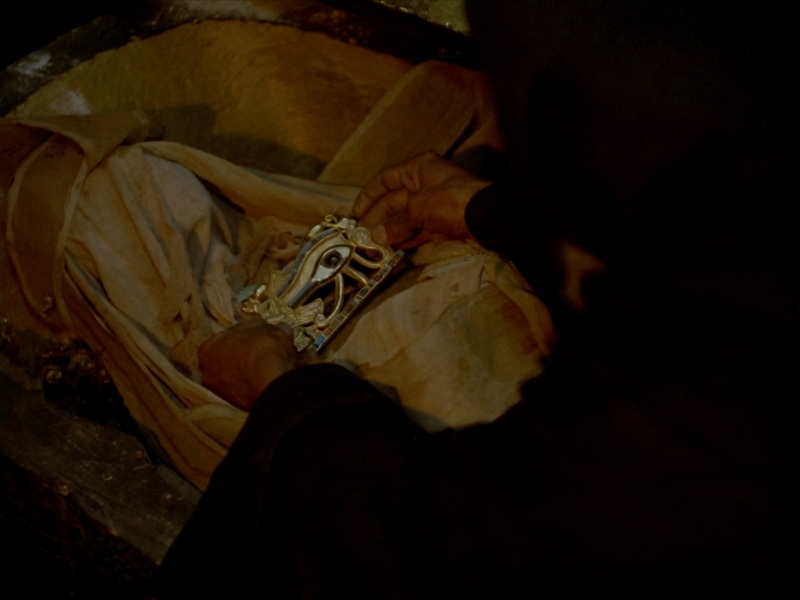
Set in 1881, on the eve of British colonial rule, The Mummy tells the true story of an Egyptian clan that has been robbing tombs for three thousand years. When Antiquities Service officials find mummies on sale in Cairo’s open market, mayhem ensues.
“Al-mummia (translates directly to The Mummy), rightfully acknowledged as one of the greatest Egyptian films ever made, is based on an incident from 1881, when it was discovered that a tribe had been secretly raiding the tombs of the Pharaohs in Thebes. An astonishing piece of cinema, the picture was extremely difficult to see from the ‘70s onward. Al-mummia [released in the U.S. as The Night of Counting the Years] has an extremely unusual tone – stately, poetic, with a powerful grasp of time and the sadness it carries. The carefully measured pace, the almost ceremonial movement of the camera, the classical Arabic spoken on the soundtrack, the unsettling score by the great Italian composer Mario Nascimbene – they all work in perfect harmony... This picture has a sense of history like no other, and in the end, the film is strangely, even hauntingly consoling – the final understanding of who and what we are.”
Martin Scorsese
“I first read the story of the discovery of mummies in Dayr alBahrī in 1956. And it became the subject of my first film. Back in 1963, while I was in Poland working on Pharaoh, my longing for Egypt during one very cold winter night drove me to think about the idea. I thought to myself: “Where is this aspect of Egypt?” From there the journey of The Mummy took off in my mind. In 1965, its first form appeared: a poem about forty lines long which I wrote in a foreign tongue. It’s not a poem in the real sense of the word, but it is a composition closely resembling poetry. After that, I started writing the scenario. At first, it was a traditional, realist film that I called Buried Again and then Wanys. But I wasn’t in a hurry and was searching for the form that would mesh completely with how I expressed myself.”
Shadi Abdel Salam1
« En 1979, un film sort au Caire. Titre Al-mumià (La momie). Sortie bâclée, public rare. Le film est depuis dix ans dans les boîtes. Il fera le tour du monde, même discrètement. On le verra à Paris. On restera bouche-bée. On apprendra à prononcer le nom de son auteur, Shadi Abdessalam et à penser qu’outre le pôle Chahine et le pôle Abou Seif, il y a dans le cinéma égyptien un pôle Abdessalam. On attendra d’autres films de lui. Aucun long ne viendra. Certains auront la chance de voir deux courts-métrages : Le paysan éloquent (1970) et Les armées du soleil (1974). Tous deux somptueux. Car appliqué à Abdessalam, le mot « esthète » est mince, presque vulgaire. Le goût de la beauté a accompagné l’homme toute sa vie (drapé dans sa cape, il avait fière allure). Pas une beauté surajoutée, en plus, mais ce qui était beau, depuis toujours, en Egypte. Depuis toujours, c’est à dire pharaons compris. Shadi Abdessalam fut unique en ceci : il filme une Egypte qui ne commence pas avec l’Egypte et son Paysan éloquent qui vient demander justice auprès du pharaon est le frère des soldats de la guerre de 73 ou de Wannis, le héros désemparé de La momie.
Serge Daney2
« Sur cette trame quelque peu policière, c’est en fait à une profonde réflexion sur le sens et le destin de l’héritage de la culture nationale – ce trésor populaire – que se livre Chadi Abdel Salam. « La momie » est un film qui doit âtre médité à plusieurs niveau. Son style, très dépouillé, presque hiératique, se distingue fondamentalement de celui de tout un cinéma égyptien gesticulator et mélodramatique. Il faut souhaiter qu’en dépit de l’hostilité des bureaucrates qu’il stigmatise ci-après, Chadi Abdel Salam puisse poursuivre par d’autres films son oeuvre prometteuses et parvenir à la renommée qu’il aurait déjà s’il était né sous d’autres cieux. »
Guy Hennebelle3
- 1Shadi Abdel Salam, “Counting the Years. Shadi Abdel Salam’s Words,” compiled by Magdi Abdel Rahman, translated by Elliott Colla, Discourse, Vol. 21, No. 1, Middle Eastern Films Before Thy Gaze Returns to Thee (Winter 1999), 127-139. Originally published in al-Qāhira 159 (February 1996): 14-21.
- 2Serge Daney, « Article de Serge Daney sur Shadi Abdessalam, » Festival des 3 continents. Ce texte a été publié dans Libération, octobre 1986.
- 3Guy Hennebelle, « Une révélation dans le cinéma égyptien : « La momie » de Chadi Abdel Salam, » L’Afrique littéraire et artistique 14, décembre 1970.

